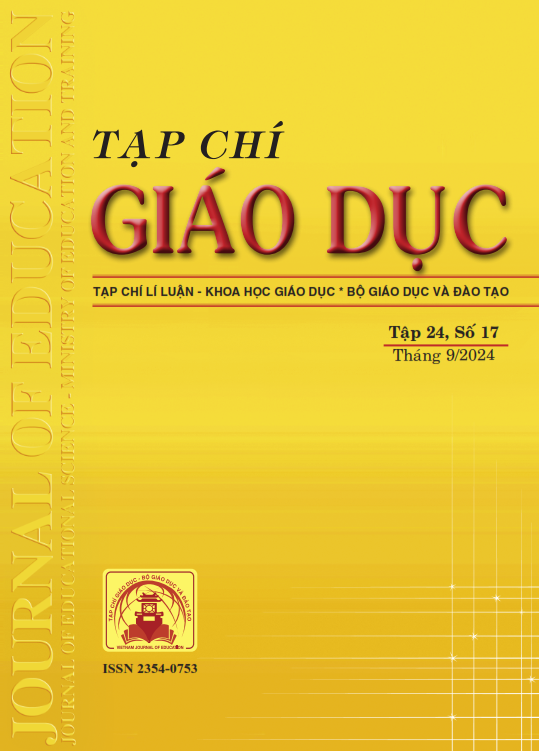Đề xuất quy trình dạy học chủ đề “Các hình khối trong thực tiễn” ở trung học cơ sở với sự hỗ trợ của công nghệ in 3D
Tóm tắt
Currently, information technology is developing rapidly and gradually becoming an indispensable part of people's lives and work. Therefore, using technology support in teaching is crucial to improve the quality of teaching. 3D printing is a technology with great potential for application in education and has attracted the attention of many researchers around the world, especially in mathematics in general and geometry in particular. However, 3D printing technology is still new and has not been widely applied in our country. This study proposes a teaching process for the topic “Shapes in practice” in middle schools with the support of 3D-printing technology and illustrates this process through a specific example. The proposed teaching process uses 3D printing technology to help teachers and students initially approach a form of teaching aimed at developing learners' capacity, putting ideas and drawings on paper into real objects in real life.
Tài liệu tham khảo
Cairns, D. R., Curtis, R., Sierros, K. A., & Bolyard, J. J. (2018). Taking Professional Development From 2D to 3D: Design-Based Learning, 2D Modeling, and 3D Fabrication for Authentic Standards-Aligned Lesson Plans. Interdisciplinary Journal of Problem-Based Learning, 12(2). https://doi.org/10.7771/1541-5015.1759
Cheng, L., Antonenko, P. “Pasha,” Ritzhaupt, A. D., & MacFadden, B. (2021). Exploring the role of 3D printing and STEM integration levels in students’ STEM career interest. British Journal of Educational Technology, 52(3), 1262-1278. https://doi.org/10.1111/bjet.13077
Dilling, F., & Witzke, I. (2020). The Use of 3D-Printing Technology in Calculus Education: Concept Formation Processes of the Concept of Derivative with Printed Graphs of Functions. Digital Experiences in Mathematics Education, 6(3), 320-339. https://doi.org/10.1007/s40751-020-00062-8
Huang, C.-Y., & Wang, J. C. (2022). Effectiveness of a three-dimensional-printing curriculum: Developing and evaluating an elementary school design-oriented model course. Computers & Education, 187(1). https://doi.org/10.1016/j.compedu.2022.104553
Huang, T.-C., & Lin, C.-Y. (2017). From 3D modeling to 3D printing: Development of a differentiated spatial ability teaching model. Telematics and Informatics, 34(2), 604-613. https://doi.org/10.1016/j.tele.2016.10.005
Huleihil, M. (2017). 3D printing technology as innovative tool for math and geometry teaching applications. IOP Conference Series: Materials Science and Engineering, 164(1).
Irwin, J. L. (2017). 3D printing implications for STEM education. In Additive Manufacturing Handbook (pp. 745-745). CRC Press.
Ng, O.-L., & Ferrara, F. (2020). Towards a materialist vision of ‘learning as making’: The case of 3D printing pens in school mathematics. International Journal of Science and Mathematics Education, 18(5), 925-944. https://doi.org/10.1007/s10763-019-10000-9
Segerman, H. (2012). 3D printing for mathematical visualisation. The Mathematical Intelligencer, 34(4), 56-62.
Sun, Y., & Li, Q. (2017). The Application of 3D Printing in Mathematics Education. In Proceeding of The 12th International Conference on Computer Science & Education (ICCSE 2017) (pp. 47-50). University of Houston.
Üçgül, M., & Altiok, S. (2023). The perceptions of prospective ICT teachers towards the integration of 3D printing into education and their views on the 3D modeling and printing course. Education and Information Technologies, 28(8), 10151-10181. https://doi.org/10.1007/s10639-023-11593-z
Wisdom, S., & Novak, E. (2020). Using 3D printing to enhance STEM teaching and learning: Recommendations for designing 3D printing projects. In Integrating 3D Printing into Teaching and Learning (pp. 187-205). Brill.
Tải xuống
Đã Xuất bản
Cách trích dẫn
Số
Chuyên mục
Giấy phép

Tác phẩm này được cấp phép theo Ghi nhận tác giả của Creative Commons Giấy phép quốc tế 4.0 .












